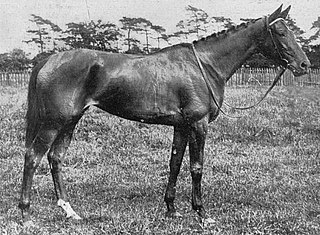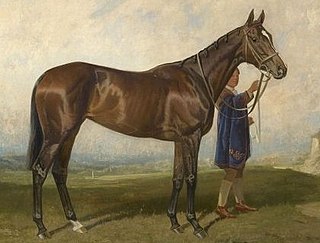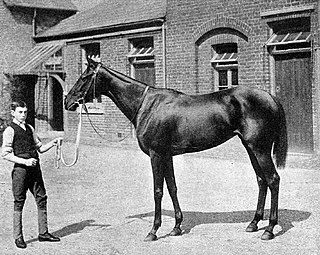Waterloo was British Thoroughbred racehorse and broodmare best known for winning the classic 1000 Guineas in 1972. Waterloo was one of the leading British two-year-olds of 1971 when her wins included the Queen Mary Stakes and the Cheveley Park Stakes. In the following year she followed up her victory in the Guineas by winning the Falmouth Stakes. She was later sold and exported to the United States and had some success as a broodmare.
Full Dress was a French-bred, British-trained Thoroughbred racehorse and broodmare best known for winning the classic 1000 Guineas in 1969. Full Dress was beaten on her first two starts as a two-year-old but then won the Crookham Stakes at Newbury Racecourse. In the following spring she won the 1000 Guineas Trial Stakes at Ascot before surviving and objection to win the Guineas. She was beaten in her two subsequent races and was retired to stud where she had some success as a broodmare.
Zabara (1949–1972) was a British Thoroughbred racehorse and broodmare best known for winning the classic 1000 Guineas in 1952. She was one of the leading European two-year-olds when her three wins included the Cheveley Park Stakes. In the following year she won the Guineas the Lingfield Oaks Trial and the Coronation Stakes as well as finishing second in the Oaks Stakes. Zabara was retired to stud where she proved to be an influential broodmare. She died in 1972 at the age of twenty-three.
Commotion was a British Thoroughbred racehorse and broodmare who raced during World War II and was best known for winning the classic Oaks Stakes in 1941. After racing over sprint distances, she was stepped up in distance the substitute "New Oaks" over one and a half miles at Newmarket Racecourse. On her next appearance she won the Falmouth Stakes and was then retired from racing. She later became a very successful broodmare.
Pure Grain was a British Thoroughbred racehorse and broodmare. In 1994 she won two of her five races including the Prestige Stakes as well as finishing third in the Princess Margaret Stakes and fourth when favourite for the Fillies' Mile. In the following year she emerged as one of the best middle distance fillies of her generation in Europe with wins in the Musidora Stakes, Irish Oaks and Yorkshire Oaks. She also finished third in The Oaks and fifth in the Prix de l'Arc de Triomphe. After her retirement from racing she had some success as a dam of winners.
Untold was a British Thoroughbred racehorse and broodmare. As a two-year-old she showed very promising form, winning two of her three races including the Fillies' Mile. In the following year she was campaigned exclusively at Group One level and emerged as a top-class middle-distance performer and stayer. She finished second in The Oaks and third in the Irish Oaks before recording her biggest success in the Yorkshire Oaks. She finished third when matched against male opposition and made favourite for the St Leger before ending her career by finishing sixth in the Champion Stakes. She had little success as a dam of winners.
Sally Brown was a British Thoroughbred racehorse and broodmare. She was owned and bred by Robert Cowell and trained by Michael Stoute. She did not race as a juvenile but emerged as a top-class middle-distance performer in 1985, winning three of her six races including the Ribblesdale Stakes and the Yorkshire Oaks. She was retired at the end of the season and had modest success as a broodmare.
Alydaress was an American-bred, British-trained Thoroughbred racehorse and broodmare. In a racing career which lasted for a little over six months from April to October 1989 she won three of her six races. After finishing third on her debut she won a maiden race and then defeated top-class fields to take the Ribblesdale Stakes and Irish Oaks. In her two subsequent races she finished second in the Yorkshire Oaks and the Gran Premio del Jockey Club. She was retired from racing at the end of the year and had some success as a broodmare.

Pia was a British-bred Thoroughbred racehorse and broodmare. She showed top-class form as a juvenile in 1966 when she won three races including the Cherry Hinton Stakes and the Lowther Stakes as well as finishing second in the Cheveley Park Stakes. In the following year she ran fourth in the 1000 Guineas and third in the Musidora Stakes before recording her biggest win in the Epsom Oaks. Later that year she dead-heated for first place in the Park Hill Stakes and ran fourth in a strong renewal of the Champion Stakes before being retired from racing. Although her foals made little impact on the track, her daughter Principia became an influential broodmare.
Ambiguity was a British Thoroughbred racehorse and broodmare best known for winning the 1953 Epsom Oaks. After finishing unplaced on her only start as a two-year-old she improved to become a top-class stayer in 1953. She won the White Rose Stakes, Oaks Stakes and Jockey Club Cup as well as finishing second in the Cheshire Oaks and the Oxfordshire Stakes. After her retirement from racing she had some success as a broodmare.
Light Brocade (1931–1947) was a British Thoroughbred racehorse and broodmare. She was one of the best two-year-old fillies in England in 1933 when she won three of her four races including the Molecomb Stakes and Cheveley Park Stakes. In the following year she finished second in the 1000 Guineas before recording her biggest win in the Epsom Oaks. She was beaten in her only subsequent start and retired with a record of four wins from eight starts. She made little immediate success as a broodmare but her female-line descendants went on to have great success in Japan.
Udaipur was a British Thoroughbred racehorse and broodmare. Her racing career consisted of eight races between April and October 1932. Having finished second on her debut and seventh in the 1000 Guineas she was still a maiden when she recorded her biggest win in the Epsom Oaks in June. She went on to win the Coronation Stakes, Richemont Stakes and Newmarket Oaks as well as finishing fourth in a strong edition of the St Leger. As a broodmare she produced several good winners and was the female-line ancestor of Wild Again.
Toboggan was a British Thoroughbred racehorse and broodmare. She showed very promising form as a juvenile in 1928 when she won three of her four races including the Dewhurst Stakes. In the following year she finished third in the 1000 Guineas and went on to win the Epsom Oaks, Coronation Stakes and Jockey Club Stakes. She had some success as a broodmare producing the top-class winner Bobsleigh and Hydroplane, the dam of Citation.

Pogrom was a British Thoroughbred racehorse and broodmare. As a two-year-old in 1921 she showed considerable promise by winning four of her six starts. In the following year she was one of the best fillies of her generation as she won the Epsom Oaks, Coronation Stakes and Newmarket Oaks and finished second on three other occasions. She made very little impact as a broodmare and died in 1933.
Keystone was a British Thoroughbred racehorse and broodmare. Having suffered from ill-health as a juvenile she recorded an emphatic win in the Epsom Oaks on her second racecourse appearance. She went on to win the Coronation Stakes and three other races as well as finishing second in the Jockey Club Stakes and a possibly unlucky fourth in the St Leger. She failed to win in the following year and was retired from racing. As a broodmare she produced the St Leger winner Keysoe and was the female-line ancestor of Display and Ballymoss.

Scuttle was a British Thoroughbred racehorse and broodmare. She showed considerable promise as a two-year-old in 1925 when she won three races including the Cheveley Park Stakes as well as finishing second in the Queen Mary Stakes. In the following spring she won on her seasonal debut and then recorded a popular and impressive victory in the 1000 Guineas. In her subsequent races she finished second in the Epsom Oaks, third in the Coronation Stakes and second in the Nassau Stakes. She was then retired to become a broodmare but died in 1934 at the age of nine. She was the first and only classic winner owned by King George V.
Plack (1921–1940) was a British Thoroughbred racehorse and broodmare. As a juvenile in 1923 when she won three races and finished second to Diophon in the Middle Park Stakes. In the following year she recorded her biggest victory when taking a very strong renewal of the 1000 Guineas and then finished second in the Epsom Oaks. Later that year she added wins in the Newmarket Oaks and the Jockey Club Cup. She failed to win in 1925 but was placed in the Coronation Cup, Hardwicke Stakes, Doncaster Cup and Jockey Club Cup. Despite producing few foals she had some influence as a broodmare.

Chelandry (1894–1917) was a British Thoroughbred racehorse and broodmare. She was the top-rated juvenile filly in England in 1896 when she won the Woodcote Stakes, Great Surrey Breeders' Foal Plate, National Breeders' Produce Stakes and Imperial Produce Stakes. In the following year she won the 1000 Guineas and finished second in both the Epsom Oaks and the St Leger. She remained in training as a four-year-old but failed to win again and was retired at the end of the year. After her retirement from racing, she became an exceptionally successful and influential broodmare.
Canterbury Pilgrim (1893–1917) was a British Thoroughbred racehorse and broodmare. She showed some ability as a juvenile but failed to win a race. She won the Oaks Stakes on her first run as a three-year-old and went on to win the Liverpool Summer Cup, Park Hill Stakes and Jockey Club Cup before being retired at the end of the year. As a broodmare the best of her offspring was Swynford, a top-class racehorse who was even better as a breeding stallion. She also produced the influential sire Chaucer and several good broodmares. She has been described as "one of the most influential horses, stallion or mare, of the Twentieth Century".
Galeottia was a British Thoroughbred racehorse and broodmare. She ran consistently well against high-class opposition as a two-year-old in 1894 although she won only one of her seven races. The filly reached her peak in the first half of 1895 when she won the 1000 Guineas and finished second in the Oaks Stakes but did not win any further major races. She had some success as a broodmare especially through her daughter Gay Laura, who produced the English Triple Crown winner Gay Crusader.




